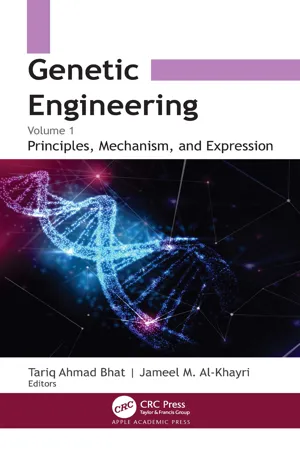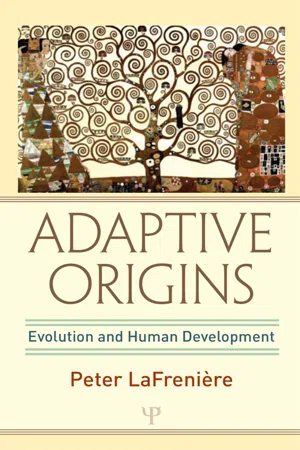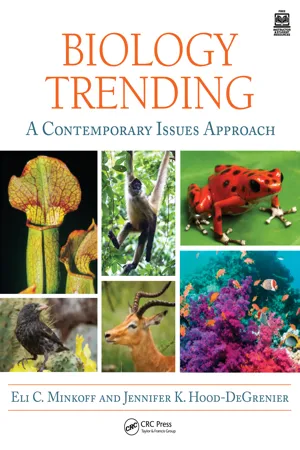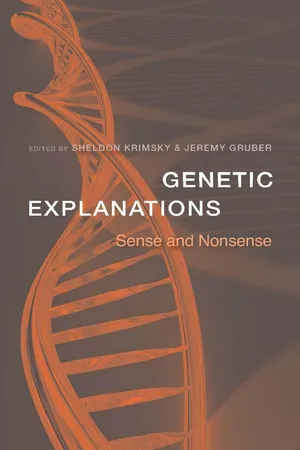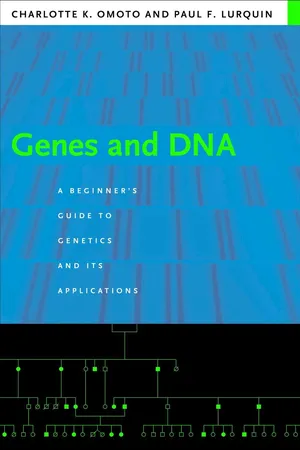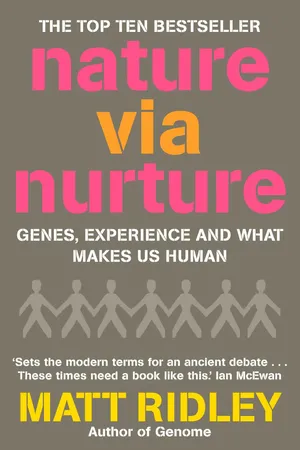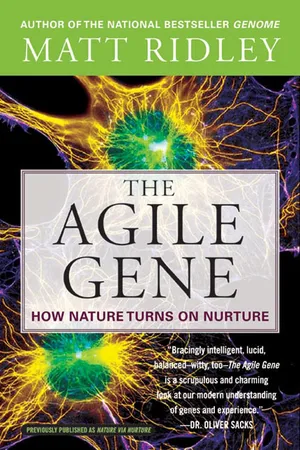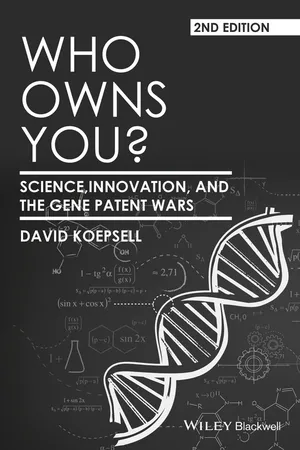Biological Sciences
Genes
Genes are the basic units of heredity that are passed from parents to offspring. They are made up of DNA and carry instructions for building and maintaining an organism. Genes determine traits such as eye color, height, and susceptibility to certain diseases. They can also influence behavior and other characteristics.
Written by Perlego with AI-assistance
Related key terms
10 Key excerpts on "Genes"
- eBook - ePub
Genetic Engineering
Volume 1: Principles Mechanism, and Expression
- Tariq Ahmad Bhat, Jameel M. Al-Khayri, Tariq Ahmad Bhat, Jameel M. Al-Khayri(Authors)
- 2023(Publication Date)
- Apple Academic Press(Publisher)
Chapter 7 Concept and Nature of GenesANJUM SABBA1 and NAJEEBUL TARFEEN21 Department of Biochemistry, University of Kashmir, Hazratbal, Srinagar, Jammu and Kashmir, India2 Center for Research and Development (CORD), University of Kashmir, Hazratbal, Srinagar, Jammu and Kashmir, IndiaAbstract
The concept of gene from mere abstract to a more complex and concrete form has been fascinating through ages now. Its precise definition has not been finalized yet by the biologists because of its dynamic characteristics and as such its deciphering continues till date. The chapter provides a glimpse of the chronological events that were taken forward for proper understanding of the concept of what basically gets transmitted from parent to the offspring in the form of gene and what it is made of, keeping in view its universal mechanism of operation which seems to be same for all living organisms with some minor variations.7.1 Introduction
The word “gene” in biology has been derived from the Greek word meaning ‘generation’ (Wikipedia) and is comprehended as trait determinant of an organism (Millard Suman). The journey of gene has started as crude, abstract form to concrete and meaningful entity and is still considered to be an evolving material and as such its precise definition is also not a static one (Peter Portin). To understand the concept of gene from simple units or elements to more complex and complicated forms of structure, one needs to go back to its historical background to comprehend it in a better possible way. A chronological sequence of events most probably will make it clear as to how much it took to make this word gene from simple units or elements to what we today know as a really complex biological store of information which can be harnessed in different ways. One of the facts of life is that living organisms continue their race by transmitting their characteristics to their offspring in a variety of ways. Some organisms transmit by budding, fragmentation, and spore formation, etc. (Sarin, 2001 ). But the most common way of transmission of hereditary to the offspring is by sexual reproduction. In all modes of transmission, the parent body, or the parts of the parent body, i.e., gametes are the physical link between the parents and their offspring. This link is the key which contains information from one generation to the subsequent generations and produce same kind yet with a variety of differences within the progeny. Mankind has been known to use selective breeding for improving quality of domestic plants and animals but sometimes the unexpected reoccurrence of undesirable traits could not be explained at that time and it needed careful analysis of transmission of inheritance pattern in progeny (Millard Suman). One such initial insights were provided by Austrian monk Gregor Johan Mendel by his tedious experiments performed in the early 1860’s and its deciphering continues till date. This term ‘gene’ was used in 1909 by Johannsen and still continues to be used till date (Johannsen, 1909 ). Both genetic as well as biochemical studies corroborated for the mechanism of transmittance of genetic material which makes us to study Genes in two broad directions, concept, and the nature of Genes, respectively (Demerec, 1961 - eBook - ePub
Adaptive Origins
Evolution and Human Development
- Peter LaFrenière(Author)
- 2011(Publication Date)
- Psychology Press(Publisher)
The molecular structure of DNA, comprised of pairs of complementary strands arranged in a double helix, was discovered by Watson and Crick in 1953. DNA is a double helix formed by base pairs attached to a sugar-phosphate backbone. Each DNA molecule is composed of a sequence of units. Each unit or nucleotide consists of a phosphate and a sugar, connected to one of four bases, adenine, thymine, cytosine, and guanine (A, T, C, and G). These four bases code for the production of amino acids, which form the building blocks of various proteins, which in turn help structure the organism’s physiology, morphology, physical appearance, and abilities. Genes are replicated in each parent and recombined in infinite variety in each offspring, except identical twins who inherit the exact same genotype from their parents. This fact alone makes twin research critical to a scientific understanding of heritability in humans, as we discuss later in this chapter.FIGURE 3.3How Genes construct the organism. Genes are composed of DNA, which can replicate one strand of itself called RNA, which contains instructions for synthesizing protein. Proteins represent fundamental building blocks of physical structures of the body and are capable of altering the body’s chemistry to aid in processes like digestion. (From Kalat, J.W. [1999]. Introduction to psychology [5th ed.]. Pacific Grove, CA: Brooks/Cole. With permission.)□ How Genes Influence Behavior and Development
As shown in Figure 3.4 , the route by which Genes influence behavior and development is indirect and always influenced by interaction with the organism’s internal and external environment. Virtually every aspect of an organism’s phenotype is the joint product of its Genes and its environment. A common misunderstanding of the relationship between Genes (the genotype) and the organism (the phenotype) is the analogy of Genes as a blueprint for the organism. Rather than following a blueprint, the genome does not actually specify a final product in intricate detail. Instead of a blueprint, Dawkins (1982) proposes the metaphor of Genes providing a recipe - eBook - ePub
Biology Trending
A Contemporary Issues Approach
- Eli Minkoff, Jennifer K. Hood-DeGrenier(Authors)
- 2023(Publication Date)
- CRC Press(Publisher)
genome ) is split between multiple chromosomes that undergo a carefully orchestrated process of segregation during cell division to ensure that the resulting daughter cells each receive a complete copy of the genome—one of each chromosome type in the case of haploid cells generated by meiosis, or two of each chromosome type in the case of diploid cells generated by mitosis. Here we will discuss further the nature of chromosomes and the process of gene expression, which is how the stored genetic information is accessed and how it influences specific functions of cells and phenotypic traits of organisms, usually by making proteins. The basic fact that Genes make proteins was initially the clever insight of a British physician, Dr. Archibald Garrod, who was investigating human metabolic disorders. Garrod discovered that a number of these disorders were linked to defects in particular enzymes (proteins that catalyze chemical reactions), which in turn were caused by changes in the DNA sequences (i.e., mutations) of specific Genes. We will explore this link later in this chapter, after we have described the steps in gene expression.Each chromosome in a genome contains two very long strands of base-paired DNA. (In humans the length of DNA in each cell is about 1 meter or 3 feet.) In most organisms, chromosomal DNA is surrounded by DNA-binding proteins, which help to compress the long DNA strand so that it can fit into the cell's nucleus (which is less than one-millionth of a meter across) and also influence gene expression. A gene is a segment of the DNA strand (a subset of bases within the linear sequence) that results in a product, which is usually a protein but sometimes an RNA end-product. Each person or pea plant (or any diploid individual) has two chromosomes of each type, and thus has two Genes for each hereditary trait, one on each chromosome of a homologous pair. Within a species, there may be several possible alleles for each gene, but each individual can only have two, one on each chromosome of a homologous pair.The process of gene expression is summarized in what is often called the “Central Dogma of Molecular Biology,” which can be stated as “DNA makes RNA, and RNA makes protein” (Figure 3.1A). The nucleic acids DNA and RNA can be compared to blueprints that contain instructions for building proteins. Genes (made of DNA) are the “master” copies of the blueprints that are stored in the “library” that is the nucleus. In the first stage of gene expression, transcription , the information contained in the DNA is copied into RNA, which can be thought of as a photocopy of the information that can be taken out of the “library” for use in the cytoplasm, where proteins are made. Most Genes undergo a second stage of gene expression, called translation - eBook - ePub
Genome Chaos
Rethinking Genetics, Evolution, and Molecular Medicine
- Henry H. Heng(Author)
- 2019(Publication Date)
- Academic Press(Publisher)
To illustrate the distinctive features between Genes and the genome, the definition of genome and a number of gene-centric–related concepts, and their limitations, are briefly reviewed, including the “selfish gene,” “minimal gene sets,” and “speciation Genes.” Furthermore, experimental examples are discussed to highlight the conflicting relationship between Genes and the genome. These analyses illustrate that gene functions are not only constrained by the genome, but, perhaps more importantly, that the characterization of genetic parts will not lead to the understanding of the emergent genomic properties of a system. The genome-level operation is not simply a matter of “adding up” the functions of individual Genes. Thus, examples of genome contexts determining or influencing gene function are presented. Alongside Chapter 1, this chapter establishes the rationale of searching for a new framework of genome-based genomic theories. 2.2. The Definition of the Genome A few decades after they were first observed by German botanist Wilhelm Hofmeister in 1848, chromosomes were suggested to be the carriers of inheritance. The chromosome theory of inheritance, introduced independently by Walter Sutton and Theodor Boveri in 1902, purported that chromosomes are the basis for all genetic inheritance. In 1889, Hugo de Vries used the term “pangen” to describe Mendel's abstract concept of an isolated genetic factor—the smallest hereditary particle (de Vries, 1889). Not until 1909 did Danish botanist Wilhelm Johannsen use the word “gene” to define the fundamental physical and functional units of heredity (Johannsen, 1909). German botanist Hans Winkler coined the term “genome” in 1920 by the elision of two terms: “GENe” and “chromosOME” (Winkler, 1920). With this historical basis, clearly, the meaning of the word “genome” should include both the whole genomic basis (chromosomes) and units of heredity (Genes) - eBook - ePub
- Sheldon Krimsky, Jeremy Gruber, Sheldon Krimsky, Jeremy Gruber(Authors)
- 2013(Publication Date)
- Harvard University Press(Publisher)
It is well known that nearly a century after Mendel published his findings, Watson and Crick correctly deduced the structure of DNA, ushering in the modern age of genetics in the 1950s. At last it became possible to begin studying how molecules that could be passed from parents to their children could influence the children’s characteristics. What is less well known is how exactly the “Genes” that have since been identified in DNA are related to the “Genes” Mendel effectively identified in the middle of the nineteenth century. Because both entities share the same name, it is generally assumed that they refer to the same things. But there is good reason to think otherwise.First, segments of DNA—which are the kinds of Genes that we typically hear about these days on the evening news—most definitely contribute to the observed characteristics of all living things.8 However, unlike Mendelian Genes—which to this day remain strictly theoretical—they do not determine those characteristics. Instead, biologists have learned that our characteristics always emerge following the process of development, which always entails interactions between DNA and environmental factors.9 These factors include both the environment outside our bodies and nongenetic factors (such as hormones, for example) that are inside our bodies (and many of these nongenetic factors in our bodies can be influenced by the environment outside our bodies). Thus, although our traits are always influenced by genetic factors, they are always influenced by nongenetic factors, too; Genes do not determine our characteristics, as Mendelian theory implies.10Second, several recent discoveries have cast serious doubt on the idea that there are coherent entities in our DNA that can unambiguously be called “Genes.”11 Perhaps the most important of these discoveries is related to a phenomenon known as RNA splicing. It turns out that genetic information is scattered among segments of DNA that do not have any currently understood purpose.12 To illustrate, imagine for a moment that information in DNA represents an instruction for the development of a characteristic (but please note that this is an imaginary scenario; in reality, the situation is quite a bit more complex than this, and many theorists would now argue that DNA is best not thought of as containing instructions).13 If the instruction we are imagining is “begin to grow an arm here,” it would ordinarily appear in the DNA scattered among purposeless information, like this: “do baryell note beginner to red dog rowing ckjswnrt bell tag an arm legitimate shopping ampere.” (In case the instruction in question appears to be completely absent in that stream of information, let me use italics to help bring it out: “do baryell note begin ner to red dog row ing ckjswnrt bell tag an arm legitimate sh opping ampere. ”) Obviously, to serve any useful function, the meaningless information—for instance, the “opping amp” segment separating the “h” from the “ere”—needs to be cut out of the sequence, and the meaningful portions must be spliced together to produce the functional instruction “here.” Crazy, right? But we now understand that this is how the system works.14 - eBook - ePub
Genes and DNA
A Beginner's Guide to Genetics and Its Applications
- Charlotte Omoto, Paul Lurquin(Authors)
- 2004(Publication Date)
- Columbia University Press(Publisher)
CHAPTER 1. What Are Genes?YOU MAY ALREADY KNOW THAT Genes are made of DNA (short for deoxyribonucleic acid). More interesting than knowing this is understanding how we know that DNA is the basis for heredity and understanding the importance of the structure of DNA for inheritance. You will see in this chapter that DNA and its structure are the keys to understanding inheritance.DNADNA has a fascinating history. The Swiss scientist Friedrich Miescher discovered DNA near the end of the nineteenth century. Miescher never knew that the substance he had isolated from sperm and pus (yes, pus!) would turn out to be so critical to the understanding of life. He died several decades before the function of DNA and its famous double-helical structure were uncovered. After Miescher, other scientists tried to identify the chemical composition of sperm, reasoning that sperm must carry the genetic material to the next generation. These scientists also reasoned that sperm cells have very little excess cellular material other than the hereditary material found in the sperm head. In fact, DNA constitutes over 60 percent of the sperm head; the remainder is mostly protein.For a long time after Miescher’s discovery, DNA was thought to be a simple molecule, consisting of nucleotides strung together like beads on a string. Each nucleotide is composed of a sugar (deoxyribose) chemically linked to phosphorus atoms and one of four different nitrogenous bases (so called because they contain a significant number of nitrogen atoms). The nitrogenous bases are adenine, guanine, cytosine, and thymine. These four bases are abbreviated as A, G, C, and T. Nothing known about the DNA molecule suggested that it could play any role in heredity. The structure of DNA seemed much too simple to account for the many already known hereditary traits. But then scientists found that the building blocks of DNA—the nucleotides—were repeated hundreds of times in the DNA molecule. As techniques to isolate DNA from living cells improved, the number of nucleotides in a DNA molecule was found to be in the thousands, and then in the hundreds of thousands. Scientists had discovered that DNA is a polymer, much like many plastics such as polyethylene and polypropylene, except that DNA is a very long polymer with millions of nucleotides, As, Gs, Cs, and Ts. - eBook - ePub
Nature via Nurture
Genes, experience and what makes us human
- Matt Ridley(Author)
- 2011(Publication Date)
- Harper Perennial(Publisher)
5 Merely by following the base-pairing rule that A must pair with T (and not C, G, or A), and that C must pair with G (and not C, T or A), each DNA molecule in two stages automatically produces an exact digital copy of its unique sequence. It needs a machine to do the copying, called DNA polymerase, but because the system is digital, it loses no precision, and because the system is fallible, it allows for evolutionary change. The Mendelian gene is an archive.A second definition of the word gene, only recently revived, is De Vries’s interchangeable part. The stunning surprise from the reading of genomes in the 1990s is that the human being has far more Genes in common with the fly and the worm than anybody expected. The Genes for laying down the body plan of the fruit fly turned out to have precise counterparts in the mouse and the man, all inherited from a common ancestor called the roundish flatworm that lived 600 million years ago. So similar are they that the human version of one of these Genes can substitute for its fly counterpart in the development of a fruit fly. Even more surprising was the discovery that the Genes flies use for learning and memory are also duplicated in people – and also presumably inherited from roundish flatworms. It is only a slight exaggeration to say that Genes in animals and plants are a bit like atoms: standard-issue parts used in different combinations to produce different compounds. The De Vriesian gene is an interchangeable part.A third definition of the gene starts in 1902 with De Vries’s contemporary, the English doctor Archibald Garrod, who rather ingeniously identified the first single-gene disease, an obscure ailment called alkaptonuria. From him descends the all too common definition of Genes by the diseases they cause when broken, the OGOD definition: one-gene-one-disease. This is misleading in two ways: it omits to mention that one mutated gene can be associated with many diseases, and one disease with many mutated Genes; and it implies that the function of the gene is to prevent that disease. This is like saying the function of the heart is to prevent heart attacks. Still, given that most genetic research is driven by medical necessity, OGOD definitions are probably unavoidable. The Garrodian gene is a disease averter, a health giver.A fourth definition of a gene is what it actually does. Right from the start, the DNA pioneers realised that Genes had two jobs: copying themselves and expressing themselves through the construction of proteins. Garrod suggested that Genes made enzymes: chemical catalysts. Linus Pauling broadened the point: Genes made proteins of all kinds. Then, four months before the discovery of the double helix, James Watson suggested that DNA makes RNA, which makes protein, a concept later jauntily dubbed by Francis Crick ‘the central dogma’ of molecular biology. Information flows out of the gene and not back into it, just as information flows from the cook to the cake and not the other way. Though many details – alternative splicing, junk DNA, transcription factors, and most recently a plethora of new Genes that make RNA but not protein, many of which seem to be intimately involved in regulating the expression of protein-coding Genes – have complicated the standard picture of the metabolic gene, the central dogma still holds. With very few exceptions, protein does the work, DNA stores the information and RNA is the link between them, as Watson guessed. So the Watson-Crick gene is a recipe. - eBook - ePub
- Cédric Gaucherel, Pierre-Henri Gouyon, Jean-Louis Dessalles(Authors)
- 2018(Publication Date)
- Wiley-ISTE(Publisher)
2 Genetic Information We started out with a view of information in the form that is most intuitive and most familiar to us, that is information in human communication. This notion of information involves a sender and a receiver, as well as a supporting code or language. We saw that this notion could easily be extended to animal communication. Can we go further, and speak of information, language and code in connection with biology in general? Of course we can. A domain of biology in which information plays a leading role, and which deserves a close study in its own right, is genetics. How this field is related to information, language, code and the specific features of that relationship are issues that we will consider in the following. 2.1. A central concept in biology Molecular biology devotes particular attention to information that is transmitted from generation to generation. The message of heredity is generally carried by an element of DNA. DNA is a linear chain consisting of pairs of nucleotides. The four nucleotides that constitute DNA are designated by the letters A, T, G and C, which stand for the corresponding molecules that are the chemical bases: adenine, thymine, guanine and cytosine. However, DNA does not resemble a string of pearls, in which each base would be one of four possible bases. Instead, it is more like a ladder (see Figure 1.1), in which each rung is a pair of nucleotides. This happens because of the affinities that exist between A and T, and between C and G. These affinities arise from hydrogen bonds that are strong enough to preserve their association, but not strong enough to make that association irreversible. The sequence of nucleotides is made complete by its complement, thus producing the well-known double helix that James Watson and Francis Crick discovered in 1953. The ladder was seen to be twisted so as to appear shaped like a helix. Each nucleotide faces its complement on this ladder – A with T, T with A, C with G, G with C - eBook - ePub
The Agile Gene
How Nature Turns on Nurture
- Matt Ridley(Author)
- 2012(Publication Date)
- Harper Perennial(Publisher)
5 Merely by following the base-pairing rule that A must pair with T (and not C, G, or A), and that C must pair with G (and not C, T, or A), each DNA molecule in two stages automatically produces an exact digital copy of its unique sequence. It needs a machine to do the copying, called DNA polymerase; but because the system is digital it loses no precision, and because the system is fallible it allows for evolutionary change. The Mendelian gene is an archive.A second definition of the gene, only recently revived, is De Vries’s interchangeable part. The stunning surprise from the reading of genomes in the 1990s is that the human being has far more Genes in common with the fly and the worm than anybody expected. The Genes for laying down the body plan of the fruit fly turned out to have precise counterparts in the mouse and the human, all inherited from a common ancestor called the roundish flatworm that lived 600 million years ago. So similar are they that the human version of one of these Genes can substitute for its fly counterpart in the development of a fruit fly. Even more surprising was the discovery that the Genes flies use for learning and memory are also duplicated in people—and also presumably inherited from roundish flatworms. It is only a slight exaggeration to say that Genes in animals and plants are a bit like atoms: standard parts used in different combinations to produce different compounds. The De Vriesian gene is an interchangeable part.A third definition of the gene starts in 1902 with De Vries’s contemporary, the English doctor Archibald Garrod, who rather ingeniously identified the first single-gene disease, an obscure ailment called alkaptonuria. From him descends the all too common definition of Genes by the diseases they cause when broken, the OGOD definition: one gene, one disease. This is misleading in two ways: it fails to mention that one mutated gene can be associated with many diseases, and one disease with many mutated Genes; and it implies that the function of the gene is to prevent that disease. This is like saying that the function of the heart is to prevent heart attacks. Still, given that most genetic research is driven by medical necessity, OGOD definitions are probably unavoidable. The Garrodian gene is a disease averter, a health giver.A fourth definition of a gene is what it actually does. Right from the start, the pioneers of DNA realized that Genes had two jobs: copying themselves and expressing themselves through the construction of proteins. Garrod suggested that Genes made enzymes: chemical catalysts. Linus Pauling broadened the point: Genes made proteins of all kinds. Then, four months before the discovery of the double helix, James Watson suggested that DNA makes RNA, which makes protein, a concept later jauntily dubbed by Francis Crick as the “central dogma” of molecular biology. Information flows out of the gene and not back into it, just as information flows from the cook to the cake and not the other way. Though many details—alternative splicing, junk DNA, transcription factors, and most recently a plethora of new Genes that make RNA but not protein, many of which seem to be intimately involved in regulating the expression of protein-coding Genes—have complicated the standard picture of the metabolic gene, the central dogma still holds. With very few exceptions, protein does the work, DNA stores the information, and RNA is the link between them, as Watson guessed. So the Watson–Crick gene is a recipe. - eBook - ePub
Who Owns You?
Science, Innovation, and the Gene Patent Wars
- David Koepsell(Author)
- 2015(Publication Date)
- Wiley-Blackwell(Publisher)
This will help nonspecialists understand its role in biology and help us to begin understanding an ontology of DNA, Genes, and metabolism. Ultimately, we will need to find the links between those rudimentary but fundamental entities as well as individuals and the much higher-level social object we call persons. We cannot complete this task here, but we can certainly define its boundaries, note its importance, and make an initial foray into this vital territory. Understanding the nature of Genes and DNA is also part of an argument I will make later about the role of individuals in directing the use of their personal DNA. As new technologies emerge that allow us to know more about our individual genetic makeup and as more of our personal genetic information becomes publicly available, or available to private for-profit concerns, it behooves us to learn more about the science. A more educated public and well-informed individuals will hopefully become better stewards of their own genetic information and make wiser choices about it. We must also understand the science to make better legal choices about how to treat it, either in legislation or by contract. DNA sampling is now included in many clinical trials, whether they are needed for genetic studies or not. These samples then become part of either private or public repositories, known as biobanks, which may be drawn upon at any time in the future for research or even mined for potential profits. Understanding the nature and science of DNA will help us make better choices about participating in clinical trials and agreeing to the use of our genetic resources. As I will argue in future chapters, it may also help ensure our privacy if we decide to call for legislation that grants new privacy rights to our personal genetic information
Index pages curate the most relevant extracts from our library of academic textbooks. They’ve been created using an in-house natural language model (NLM), each adding context and meaning to key research topics.
